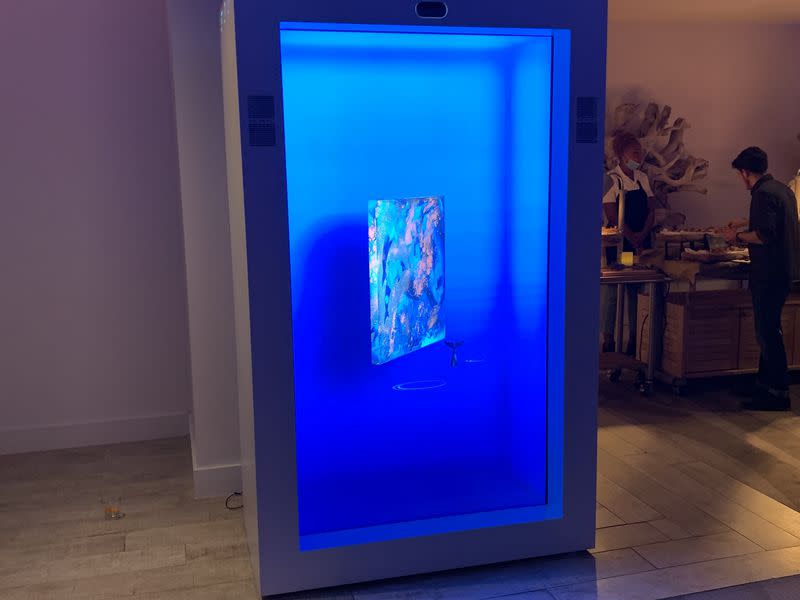Hologram NFTs at Art Basel Miami Are Trying to Save the Oceans
Non-fungible tokens (NFTs) masquerading as holograms, raising funds to save the oceans: It’s happening at this year’s Art Basel Miami Beach.
That’s where the Open Earth Foundation, a tech platform for climate action, is holding its OceanDrop NFT sale, following its CarbonDrop NFT sale earlier this year, which raised some $6.6 million.
(This year’s Art Basel event in Miami is a de facto crypto conference in light of 2021′s frantic enthusiasm for NFTs.)
Open Earth Foundation Executive Director Martin Wainstein says the goal is to use blockchain tech to accurately account for carbon in the atmosphere, as well as realize global agreements to preserve 30% of the ocean and 30% of the land.
The money raised from auctioning OceanDrop NFTs will be used for a new program called OpenOcean, said Wainstein. The effort will fund a project on Cocos Island off the coast of Costa Rica, supporting local nongovernmental organizations (NGO) and park ranger operations.
Read more: Artists Back ‘Green’ NFT Sale Citing Concerns Over Crypto’s Environmental Impact
OceanDrop, which is supported by the likes of SuperRare, DoinGud and RNDR, is attempting to push the envelope on NFT innovation. All the digital artworks and animations in the sale will feature holograms using holographic technologies such as Portl.
“We think this is going to be a very important role for museums that want to display digital sculptures and things like that,” Wainstein said.
The artists
The OceanDrop NFT auction includes contributions from 21 artists, a mix of established and up-and-coming names.
Included in that mix is Nicole Buffett, the estranged granddaughter of investing guru Warren Buffett. She had previously been working with Open Earth and also explored hologram versions of a dolphin-themed piece leading to the OceanDrop NFT.

Buffett has been working with NFTs for a little over a year now and has four collections on OpenSea, all of which have sold out.
“With all my NFT sales I like to support charitable causes with a portion of the proceeds going to different funds and different causes,” Buffett said in an interview. “I think there’s a lot of capacity, given the abundance of money generated in the space, to really be bringing in that culture of charity.”
Something Nicole Buffett gets asked about often is how her enthusiasm for crypto technology contrasts sharply with the views of her grandfather, who famously called bitcoin “rat poison squared.”
“I just think [crypto] is another language, it’s another financial language, and he’s not interested in learning it,” Buffet said. “But I love it. I’m not really that into traditional Wall Street portfolio, stock market stuff. So probably the way he feels about crypto is probably the way I feel about traditional finance.”
‘Polarizing’
Academy Award–winning digital artist Kevin Mack is making his first foray into NFTs with OceanDrop. His piece is called “Nammu: Ancient Elder From The Distant Future.”
Mack says that while his work is fundamentally abstract, it’s heavily influenced by undersea life and reflects his growing up scuba diving in Santa Catalina, an island off the coast of Southern California.

The 30-year veteran of immersive art and computer graphics says he’s been “skirting around” NFTs for a long time now because the concept is “so polarizing for a lot of people.”
“There’s really a lot of strong advocates of the NFT thing and decentralized currency in general. And then there are people who think it’s actually not a good thing,” Mack told CoinDesk. “I think the biggest argument against it is this notion of imposing artificial scarcity on a thing that is infinitely reproducible without loss. So, I think there’s still a little ambivalence about it. But if they can raise money to help the ocean, then yeah, I was willing to participate.”
Ocean to ocean
Canada-based digital artist Will Selviz was born in Venezuela, grew up in Kuwait, and now faces the Pacific Ocean in Vancouver. The piece Selviz has donated is an animation called “Sin Agua No Hay Tiempo” (“Without Water There Is No Time”).
“I feel like my whole life I’ve moved from one sea to another, from one ocean to another,” Selviz told CoinDesk. “I don’t want to call it a duty or a job, but I’ve tried to help take care of those places wherever I’ve lived, and have taken part in beach cleanups and whatnot.”
Selviz, who did his first NFT drop about a month ago at NYC.NFT, is also the founder of the RENDRD Foundation (not to be confused with RNDR, the token), whose main goal is to provide access to underrepresented communities, such as Black youth, within the digital animation industry.
“All these things got me down this rabbit hole of figuring out how to fundraise and build a community through NFTs and crypto,” Selviz said.

Humbled
For the Open Earth Foundation’s Wainstein, the CarbonDrop NFT sale back in March was life-changing. As a result, Open Earth established both crypto and traditional endowments to maintain climate accounting research for the next nine years, said Wainstein.
“At the beginning of the year, I wouldn’t have been comfortable launching parallel programs,” Wainstein said. “But because of the CarbonDrop, we’ve established a structure as an NGO that enables us to scale.”
Asked if he expects to raise as much as the CarbonDrop sale, Wainstein says he likes to be humble when it comes to fundraising targets.
“Our target for success is $250,000,” Wainstein said. “It’s about what’s the minimum amount that we need to launch a program that will make a dent in the sector. And that’s roughly what we think is the minimum to launch a program, to hire a team of oceanographers and blockchain experts to work together.”

 Yahoo Finance
Yahoo Finance 